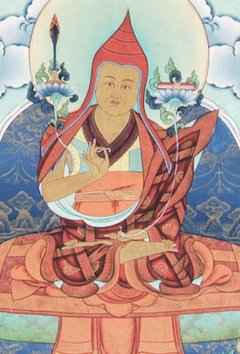Advice for Palseng
English | Français | Português | 中文 | བོད་ཡིག
Advice for Palseng
by Dodrupchen Jigme Tenpe Nyima
I bow respectfully to the guru, Drimé Özer,
And, with folded hands, pay homage.
Here, a tiny droplet of instruction from
The omniscient guru, I shall now explain.
On the subject of what we call 'mind' (sems) and 'pure awareness' (rig pa), some common scriptures say that all that is 'main mind' is mind, while cognition is what is 'clear and aware'. They thus claim that mind is synonymous with consciousness (rnam shes), while awareness is synonymous with cognition (shes pa). Yet such explanations are insufficient when it comes to identifying mind and awareness as they are spoken of in the Dzogchen texts.
In Dzogchen, mind is the root of saṃsāric existence and includes a tendency to cling to things as real; while pure awareness is the wisdom of settling evenly in accordance with intrinsic reality (dharmatā). What is more, this is not like the mere common view of the Middle Way; it is superior because it brings about a special kind of certainty through the reasoning that proves how the buddhas' insight into how things are is present as the perfect ground of ordinary beings' basic nature. On an ultimate level, both true existence and the absence of true existence are understood to be equal, and all theoretical posturing is therefore overcome in the face of ultimate reasoning. On the conventional level, too, this approach is superior because it incorporates the practice of viewing all phenomena as infinite purity.
This Dzogchen approach is also superior to the outer mantra vehicles, as it incorporates the profound key point of seeing phenomena as buddha-forms and wisdom, then settling, without contrivance, in the great natural condition. It is also superior to the vehicle of the transcendent perfections because it involves viewing phenomena as infinite purity. And it is superior to the outer mantra vehicles, because even though these tantras have deity yoga, they do not have the view which recognises that, in their natural state, these appearances have always been enlightened as buddha-forms and wisdom. It is also more profound than Mahāyoga and Anuyoga, because there is no need to train in the generation and completion stages, both of which involve effort. Instead, since all phenomena are recognised as primordial enlightenment, and the radiance of pure great wisdom, it is sufficient simply to abide by a recognition of this, relaxing in the nature of the ground.
This differs from the approach taken by some contemporary meditators, those who merely settle in delusory perception without cutting attachment to reality at its very root, and without realising the nature of infinite purity.
More details on how the nature of the conventional is buddha-forms and wisdom, or how ultimately both pure and impure are alike in lacking true nature, as well as proofs of how appearances are infinite purity and so on, can be found in the works of the omniscient Rongzom and victorious Longchenpa.
In short, I wonder whether alternating in meditation between analysis, for as long as certainty about these points has not yet arisen, and settling, when certainty has arisen and does not wane, might not be an authentic means of sustaining this understanding.
Any foolish, mistaken analysis,
Or foolish talk, triply invalid,[1]
In what I have here set down
Is due to me, the foolish one.
Still, if anything here is of value,
Take it as your own adornment.
I, the youthful Jigme, wrote this in response to Palseng's request. May it be virtuous!
| Translated by Adam Pearcey, 2015.
Bibliography
Tibetan Editions
’jigs med bstan pa’i nyi ma. "dpal seng gi ngor gdams pa" in rDo grub chen ’jigs med bstan pa’i nyi ma’i gsung ’bum. 7 vols. Chengdu: Si khron mi rigs dpe skrun khang, 2003. BDRC: W25007, vol. 2, pp. 53–55
______. "dpal seng gi ngor gdams pa" in rDo grub chen ’jigs med bstan pa’i nyi ma’i gsung ’bum. 5 vols. Gangtok, Sikkim, 2000? BDRC: W23907, vol. 1, pp. 496–498
Secondary Sources
Krang dbyi sun (Zhang Yisun), ed. Bod rgya tshig mdzod chen mo. 3 vols. Beijing: Mi rigs dpe skrun khang, 1985.
Tulku Thondup, Masters of Meditation and Miracles: The Longchen Nyingthig Lineage of Tibetan Buddhism. Boston: Shambhala, 1996.
Version: 1.4-20220320
-
dpyad gsum ma dag pa, i.e., invalid on three levels: 1) the apparent level, as it conflicts with what can be perceived directly; 2) the hidden level, as it conflicts with what can be correctly inferred; and 3) the extremely hidden level, as there are inconsistencies within the text itself. See "dpyad pa gsum gyis dag pa'i lung" in Bod rgya tshig mdzod chen mo, vol. 2, pp. 1643–1644. ↩
